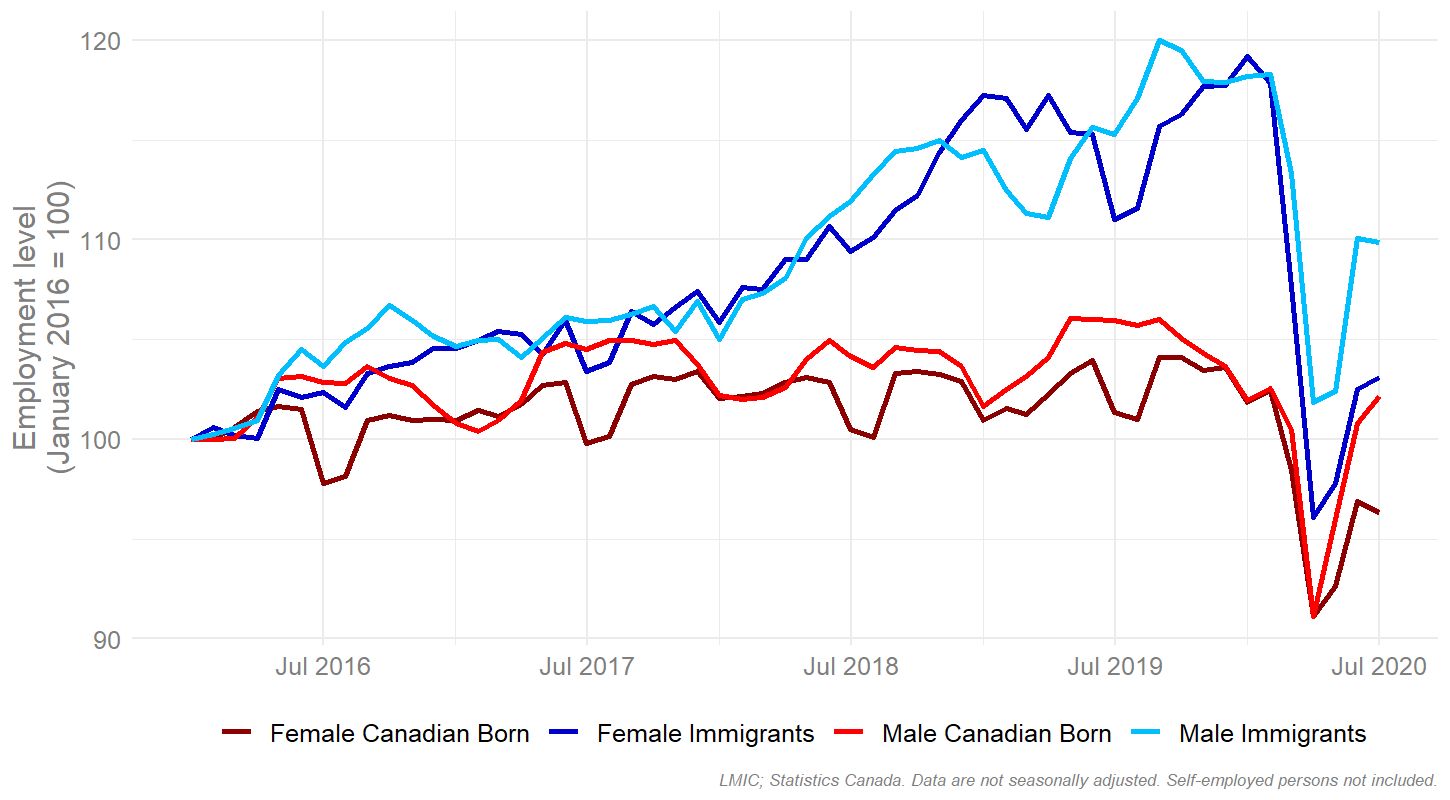
Immigrant Employment in Sectors Most Affected by COVID-19
Immigrants have suffered greater job losses during the COVID-19 pandemic than Canadian-born workers. Our recent blog post illustrates that employment dropped, in relative terms, for landed immigrants at nearly twice the rate of their Canadian-born counterparts. In addition, since April the recovery has been slower for immigrants. Data from July show that among prime aged workers (25-64) Canadian-born workers have recovered 72% of the jobs lost in March and April versus a 40% recovery for landed immigrants (these figures are not seasonally adjusted). Yet at only 32%, the job recovery rate has been even lower for immigrant women than for their male counterparts.
Slowest Recovery for Female Immigrants
Figure 1 shows that during the peak months of the shutdown — between February and April 2020 — female landed immigrants suffered the worst job losses. However, male landed immigrants also fared worse than Canadian-born workers of either gender. The figure also shows that the recovery between April and July has been particularly slow for female immigrants. This group has recovered only 32% of the jobs lost, whereas the recovery rate has been 49% for male landed immigrants and 46% for Canadian-born female workers. Among Canadian-born men, 96% of the lost employment has been recovered as of July. Note that the speed of recovery between June and July has been slower than the one between April and June.
Figure 1: Employment level by gender and immigrant status (aged 25-64), July 2016–July 2020.

Immigrants in the Most Affected Sectors
The labour market impact of the pandemic is heavily driven by the industry in which one works. Both male and female immigrants were more likely to work in heavily affected sectors. Overall, the greatest job losses occurred in two sectors with more than 50% representation of women in the workforce: accommodation and food services (56% women) and retail trade (52% women).
Table 1 shows the employment recovery rates from April to July 2020 for the two most affected sectors for each group. Canadian-born female workers had the fastest recovery in accommodation and food services (82%), while Canadian-born male workers had the highest recovery rate in retail trade (86% versus 65% for Canadian-born women). In both sectors, immigrants experienced the slowest recovery in employment. Only 21% of jobs recovered for female immigrants in accommodation and food services, while they had a higher recovery rate (39%) in retail trade compared to their male counterparts (26%).
Table 1: Employment Recovery Rate from April to July 2020, Two Most Affected Sectors
| Recovery Rate* | ||
| Population Groups | Accommodation and food services | Retail trade |
| Female, Canadian born | 82% | 65% |
| Female, Immigrant | 21% | 39% |
| Male, Canadian born | 80% | 86% |
| Male, Immigrant | 53% | 26% |
*Recovery Rate: Employment change between July and April divided by the employment change between April and February; absolute value. Data are not seasonally adjusted. Self-employed persons not included. Data not seasonally adjusted and include prime aged workers (25-64). Sources: LMIC and Statistics Canada.
The Way Forward
Recent data from the Labour Force Survey show that among all workers, female immigrants suffered the worst job losses during the peak of the pandemic and the slowest recovery since then. This is partly due to their large representation in one of the hardest hit sectors of the economy: accommodation and food services. However, female immigrants had a higher recovery rate in retail trade compared to male immigrants since April.
LMIC will continue to analyze data as they become available to deliver more insights about the labour market and the current recession, especially the greater impacts on underrepresented groups. Stay tuned for more timely, granular insights from LMIC in the coming weeks and months.

Behnoush Amery is a Senior Economist with LMIC. Her work currently focuses on labour market information research related to the future of work, the relationship between education and labour market outcomes, as well as the estimation of granular labour data.
behnoush.amery@lmic-cimt.ca